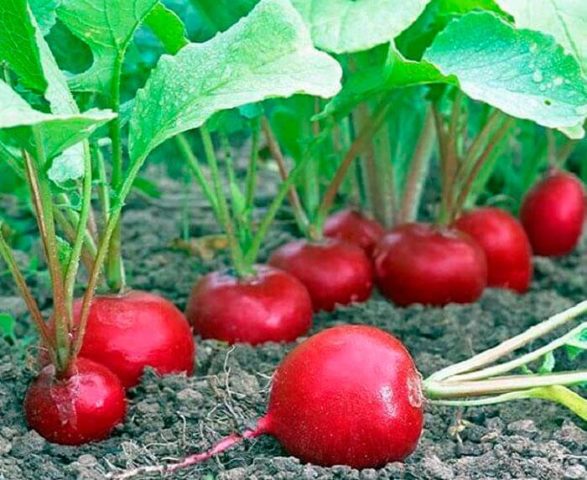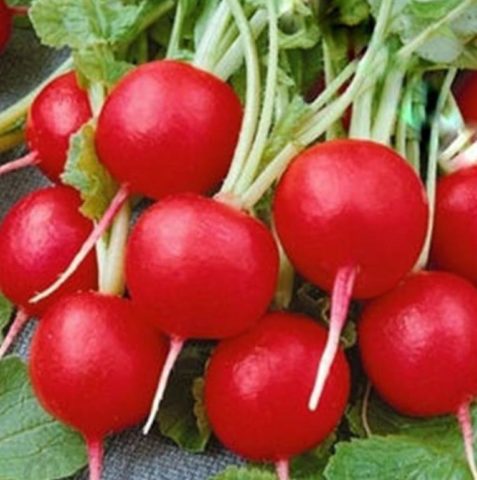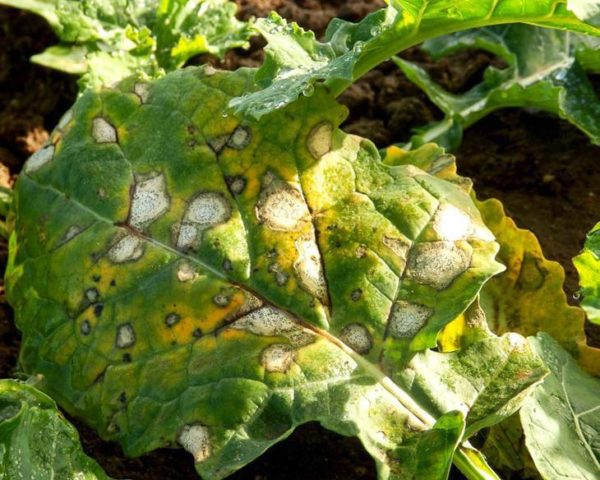Content
Radish varieties that are resistant to bolting are distinguished by their unpretentiousness, high yield, and attractive spring appearance. Hybrids are suitable for continuous sowing from April to October in open ground, a greenhouse or greenhouse.
What is the advantage of non-shooting radish varieties?
Breeders are continuously working to develop radish varieties without bolting ability. It is not yet possible to completely remove the “color gene”. Under unfavorable conditions, the plant grows tops, produces a peduncle, and then root crops do not form.
To date, it has been possible to develop relatively resistant varieties. These radishes grow well in open areas or in a greenhouse. It does not respond to day length and is suitable for sowing throughout the entire season: from April to September, without a break in the summer months.
Hybrids are drought- and heat-resistant, capable of growing in shaded or, on the contrary, open areas.
An important advantage of non-shooting varieties is their high yield.The fruits develop well and gain weight, they do not crack, do not become woody, and are resistant to hollowness.
How do radish varieties that are resistant to bolting differ from regular ones?
The main difference between non-shooting radish is its immunity to daylength. Even when planted between July and August, with proper care, such varieties do not produce a peduncle.
Due to the absence of bolting, the crop has advantages:
- varieties give a consistently high yield: from 1 sq. m collect 2 - 4 kg;
- root vegetables grow larger than those of ordinary species: their weight reaches 40–50 g, diameter – 4–6 mm;
- radishes are stored longer, are more suitable for transportation, and have a good presentation.
In addition, the lack of flowering has a beneficial effect on the taste of root crops. The pulp of non-shooting radishes is always juicy, crispy, dense, and not prone to woodiness, cracking or flabby.
Varieties of non-shooting radish
Breeders have developed several early, mid-season and late varieties that are relatively resistant to bolting. To choose a suitable hybrid, you should familiarize yourself with the description of the appearance and taste of the varieties, the advantages and disadvantages of each of them.
Presto
Ultra-early ripening variety without bolting. It is suitable for sowing in protected or open ground. In addition, it is undemanding in terms of agricultural technology, humidity, and lighting.
Seeds are planted in April-May. The ripening period for non-shooting radishes is 15–18 days.
The variety has good yield. The root crops of the crop are red, round, and even in size. Their white flesh is dense, juicy, and does not become woody during long-term storage.
Zlata
One of the most popular varieties of non-shooting radishes among summer residents.
The plant tolerates dry, hot weather well and practically does not react to the length of daylight hours. It is resistant to diseases and pests. Suitable for long-term storage and transportation.
The variety is early ripening. Harvesting is carried out within 20 - 25 days after germination. At low temperatures, ripening is delayed up to 30–33 days. The crop yield is assessed as consistently high. From 1 sq. m under favorable conditions, up to 2.5 kg of radishes are harvested.
The roots are round, slightly rough, with a bright yellow color. The white flesh is tender, juicy, with a pleasant tangy taste.
This non-shooting variety is suitable for sowing in an open area or under film. Due to its high drought resistance, it grows well in greenhouses and greenhouses.
Mercado
A non-shooting mid-season radish variety bred in Japan. The ideal time to plant it is mid-April. The culture is suitable for growing in a greenhouse, open ground or greenhouse.
From germination to harvest, 25–30 days pass. Mercado has earned fame as a leader in yield. From 1 sq. m harvest up to 3.5 kg of large, raspberry-red fruits. The weight of each of them, with proper agricultural technology, reaches 20 g.
The pulp of the root vegetables is light pink, slightly whitish with a sweet, slightly spicy taste. Non-shooting radishes are not prone to sagging or woodiness and are well stored.
Duro Krasnodar
The variety is suitable for planting in early spring, starting in mid-April. Seed germination rate is 99%. It is possible to grow the crop both in open and protected ground throughout the entire season. The variety is undemanding to soil composition.
Duro is resistant to bolting, void formation, and woodiness. It produces consistently high yields. From 1 sq. m with proper agricultural technology, up to 2 kg of selected radishes are harvested. The fruits of the crop are smooth, spherical, with red skin. They reach 10 cm in diameter. The white, juicy pulp has a good taste with a slight bitterness.
Ilka
Mid-season radish variety, resistant to bolting. Its main advantages: consistently high yield, presentation, long shelf life.
The variety is suitable for sowing in open ground or a greenhouse in May-June, as well as September.
Its fruits are red with white, fleshy, juicy pulp, round. Their diameter reaches 3–5 cm. Their taste is sweetish and moderately spicy.
The culture is not susceptible to diseases and pests.
Tarzan
Mid-season variety, resistant to diseases and bolting. With proper care, the plant produces a consistently high yield: up to 2 kg per 1 sq. m.
The fruits are red, round in shape. The weight of each of them can reach 50 g. Their white flesh is juicy, dense, with a pleasant taste. Non-shooting radishes keep well in the refrigerator. Under optimal conditions, it does not deteriorate or mold within two months.
The best time for planting is April. Root crops ripen within 27 – 35 days.
Vera MS
Mid-season, high-yielding variety of radish, resistant to bolting. The harvest ripens in 28 - 35 days. With proper agricultural technology and favorable weather conditions, from 1 sq. M harvest up to 4 kg of large (diameter up to 4.5 cm), spherical root crops.
This non-shooting radish has excellent taste. The juicy pulp of root vegetables is dense, white, with pink veins, not prone to woodiness, cracking or hollowness.
The crop is suitable for any growing conditions, is practically insensitive to daylight hours, and is not afraid of infections and pests.
This non-shooting variety is distinguished by its good keeping quality and attractive presentation.
Rampoush
Late-ripening variety without bolting, suitable only for open ground. The period of full ripening is 35 – 40 days.
The root crops of the crop are elongated, oblong, pink-red or milky-white in color. Their skin is smooth, without strong root branches. The pulp is white with a sharp, but without pronounced bitterness taste.
In appearance and characteristics, this hybrid resembles daikon.
Features of growing non-shooting radishes
Planting and caring for bolting-resistant varieties is practically no different from growing ordinary radishes.
Plants are sown early, in April, so the soil must have time to warm up. For planting, choose fertile areas where the snow melts first. At low temperatures, non-shooting radishes go into the tops, and the root crops become smaller.
The best predecessors of varieties resistant to bolting are cucumbers, tomatoes, and potatoes. Radishes develop well in the vicinity of carrots, legumes, and parsley. You should not plant the plant after cruciferous vegetables (cabbage, broccoli, turnips). They are natural green manures that oversaturate the soil. As a result, the root crop grows thick foliage, and the plant’s yield decreases.
Before planting the seeds, the area is well dug up and loosened. When sowing in summer, the furrows are additionally watered.
Non-shooting varieties are susceptible to planting density. The optimal distance between roots is 4–5 cm, leaving 8–10 cm between rows.If the planting pattern is violated, the root crops will be small and there is a possibility of flowering.
In spring, seedlings need sufficient watering 3-4 times a week. During fruit growth and during drought, non-shooting varieties are irrigated daily with large amounts of water (10 liters per 1 sq. m). After watering, the soil is loosened and mulched with sawdust.
Organic fertilizers are applied in the fall. Spring feeding promotes leaf growth and bolting. If necessary, if the area was not treated in the fall, complex minerals and nitrogen-containing preparations are added.
In the case of summer sowing, the seedlings must be shaded.
When planting radishes in a greenhouse, the soil composition should include peat or compost (with turf in a 1:1 ratio). In greenhouse conditions, much attention is paid to ventilation, humidity and lighting.
Pests and diseases
Radishes are crops that are resistant to pests and infections. During the short growing season, fungal or viral diseases do not have time to develop, and insect larvae do not have time to enter the adult stage and cause significant harm to the plant.
With improper care, violation of the irrigation regime, or general contamination of the area, the following diseases may appear on non-shooting radish varieties:
- Powdery mildew. Fungal infection of radish leaves. It spreads in hot, humid weather, during sudden temperature changes, or in proximity to diseased plants. At an early stage, the leaves become covered with a white powdery coating, which then darkens and brown spots appear on the crop.Treatment: spraying radishes with infusion of wood ash, horsetail rhizomes, colloidal sulfur solution, curdled milk or sour milk. Neglected powdery mildew is treated with fungicides. Without treatment, the yield of non-shooting varieties drops by half.
- Radish mosaic. A viral incurable disease that affects leaves. When infected, they become covered with yellowish-green or light green spots, thicken, and become smaller. The radishes stop growing and the fruits do not develop. There is no cure for this disease. In order to stop the spread of infection, damaged plants are removed and burned.
- Blackleg. A fungus that attacks young shoots of non-shooting radishes. Develops with improper watering. At the same time, the root collar begins to rot, turn black, and become thinner. The plant collapses, turns yellow and dies. For prevention, before planting, radish seeds are soaked in a solution of potassium permanganate, the bed is watered with boiling water, and young shoots are sprinkled with charcoal.
- Gray rot. The disease develops due to excessive watering. It is diagnosed by the characteristic gray fluffy coating on the fruits and leaves of radishes. To prevent the development of rot, crushed activated carbon, wood ash, and colloidal sulfur are periodically added to the soil.
Radish leaves that are resistant to bolting are attacked by insect pests:
- Cabbage butterfly caterpillars. Over the summer, the insect manages to hatch two generations of offspring - in June and September. The larvae quickly eat the leaves, preventing the radish from growing normally and forming root crops. To scare off butterflies ready to lay eggs, non-arrowing varieties are sprayed with an infusion of herbs or spices with a strong aroma (wormwood, basil, cinnamon, citrus fruits, rosemary).
- Cabbage fly. The larvae deposited in the soil damage the roots of young seedlings and developing root crops, eating them away from the inside. To repel insects, the garden bed is sprayed with infusion of tobacco or bay leaf.
- Cruciferous bug. These are bright red and black beetles that suck out the juice, damage the leaves and petioles of the radish, depriving it of nutrition. Parasites cannot tolerate the smell of tansy, onion peel, or chamomile.
- Slugs. They reproduce in high humidity. An invasion of slugs can completely destroy crops of non-shooting radishes. They destroy leaves, petioles, and roots. It is difficult to remove pests from the site. To do this, they set traps, collect pests by hand, and spray the beds with an infusion of hot pepper or mustard powder.
- Aphid. It settles on the underside of leaves, which turn yellow and become deformed over time. To remove the colony, the tops are washed with a solution of laundry or tar soap and treated with insecticides.
In addition, on radishes that are resistant to bolting you can find:
- cabbage moth;
- rapeseed flower beetle;
- cabbage fire;
- cruciferous flea beetle;
- wireworm;
- rapeseed sawfly larvae.
Infusions of tobacco, bay leaves, ground hot pepper, mustard powder, potassium permanganate and laundry soap help cope with insect infestations. In extreme cases, insecticides are used to save the crop.
Conclusion
Gardeners are increasingly choosing bolting-resistant radish varieties for sowing in their garden plots.Such hybrids are suitable for any growing method. They are not demanding on the length of daylight hours, soil composition, or humidity level. Plants are resistant to diseases and pests. Non-shooting varieties with proper care always produce a high-quality, high yield of dense, crispy fruits with excellent taste. They are suitable for long-term storage and transportation.

































